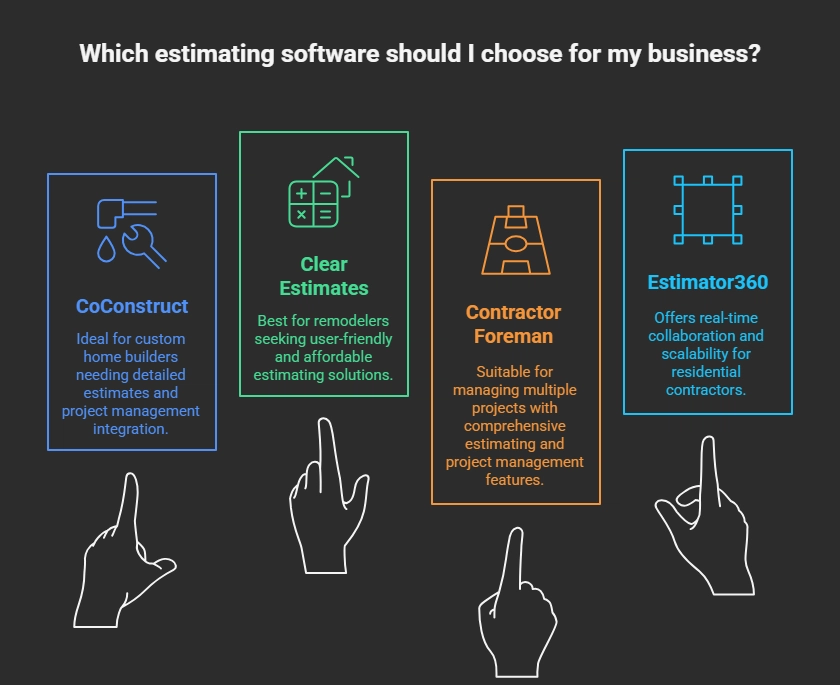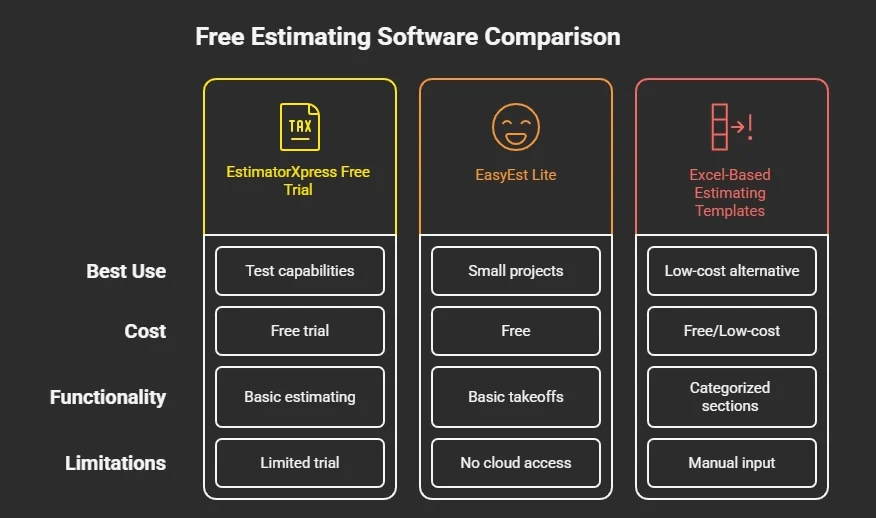Tools like Buildxact, Cubit, and CostX stand out among estimating software for residential construction, helping builders manage takeoffs, quotes, and job costing seamlessly. These platforms integrate live supplier pricing, automate material updates, and ensure accurate cost forecasting, improving transparency across Australia’s growing housing and renovation sectors.
Best Estimating Software for Residential Construction

Selecting the right tools is critical for residential builders aiming to stay competitive. Construction Estimating Software offers a reliable way to meet diverse needs, from custom home builds to renovations, while providing user-friendly interfaces and robust features.
CoConstruct: Tailored Estimating for Custom Home Projects
Designed for builders handling unique residential designs, this platform merges estimating precision with project management in one workflow. By updating material and labour prices in real time, CoConstruct helps contractors deliver accurate, client-ready quotes that reflect true construction costs and market conditions.Estimates and Proposals | CoConstruct
CoConstruct’s tailored estimating for custom home projects extends to seamless client communication and schedule control. Its mobile app enables instant quote adjustments on-site, while integration with accounting tools ensures transparency from concept to completion, making it indispensable for bespoke Australian home builders.
Clear Estimates: Simplified Estimating for Remodelers
For remodelers, remodeling estimating software like Clear Estimates offers a clean, web-based interface. Designed by industry pros, it simplifies cost breakdowns for renovations, with pre-built templates for kitchens, bathrooms, and extensions. A Sydney remodeler, for instance, can input project specs and get a professional quote in minutes, complete with local pricing data.
Clear Estimates is affordable, starting at $65/month, and accessible on any device, making it perfect for small teams. However, its limited third-party integrations may require manual data transfers for larger projects.
Contractor Foreman: Estimating Plus Project Management
Bringing together best estimating software for builders with project management tools, Contractor Foreman offers a cloud-based platform that supports digital takeoffs, cost tracking, and scheduling. It is ideal for builders managing multiple jobs. For instance, a Brisbane contractor used Contractor Foreman to estimate a duplex project, cutting takeoff time by 50% compared to manual methods.
While its learning curve can be steep for new users, the all-in-one approach ensures estimates flow into budgets and schedules, reducing admin work and improving accuracy.
Estimator360: Cloud Estimating for Residential Contractors
As a cloud-based solution tailored for residential contractors, Estimator360 enables real-time collaboration where teams can update estimates simultaneously. Its digital takeoff tools and cost databases support the creation of precise quotes. For example, a Perth builder used Estimator360 to estimate a single-storey home, factoring in local material costs for greater accuracy.
The platform’s scalability suits both small and large projects, but its higher cost may deter sole traders. Free training and support make onboarding smoother.
Free Estimating Software for Residential Construction

For small builders or those starting out, free estimating tools can be a cost-effective entry point. While limited in scope, these options provide practical solutions for basic needs.
EstimatorXpress Free Trial: Entry-Level Estimating
With a 14-day free trial, EstimatorXpress makes it easy to test estimating capabilities before committing. The platform provides templates for common residential projects such as single-storey homes or extensions. For example, a Gold Coast builder used EstimatorXpress to estimate a small renovation, leveraging regional cost data without upfront expenses.
EasyEst Lite: Free Estimating for Small Projects
EasyEst Lite is a free tool for small residential projects. It supports basic takeoffs and cost calculations, perfect for sole traders. For instance, a rural Victorian builder used EasyEst Lite to quote a deck installation, saving hours compared to spreadsheets. Its simplicity is its strength, but it lacks cloud access, limiting collaboration. It’s best for straightforward, low-budget jobs.
Excel-Based Estimating Templates: Low-Cost Alternative
Residential estimating software offers a more reliable upgrade to Excel templates like Smartsheet, which rely on manual inputs. While templates let Tasmanian builders customise costs for materials and labour, digital tools automate pricing, apply live market data, and cut human error across complex residential projects.
How Estimating Software Reduces Cost Overruns in Residential Projects
Cost overruns remain a persistent issue in residential construction, with studies showing many Australian projects exceed budgets by 10–20%. Estimating software addresses this challenge by automating calculations, integrating real-time supplier data, and flagging risks early. These tools enable builders to anticipate costs accurately and avoid unexpected overruns that undermine profitability.
One of the primary benefits of accurate software project estimation is the ability to allocate resources efficiently. By understanding the scope and complexity of the project ahead, teams can assign the right number of developers and allocate the correct budget, ensuring that projects are not under or over-resourced.Software Project Estimation
How Accurate Are Residential Estimating Tools Compared to Manual Methods?
Residential estimating software significantly outperforms manual methods, delivering up to 90% accuracy compared to 70% with spreadsheets. Platforms like Procore leverage digital takeoffs and cost databases to minimise errors; for example, a Geelong builder using Procore reduced estimate discrepancies by 15% on a multi-unit project.
What Limitations Should Builders Be Aware of Before Relying on Estimating Tools?
While powerful, estimating software has limitations. Here are key considerations:
- Learning Curve; Tools like Buildxact require training, which can delay adoption for busy contractors.
- Cost; Subscriptions, like CoConstruct’s $99/month plan, may strain small budgets.
- Internet Dependency; Cloud-based platforms need reliable internet, a challenge in remote Australian sites.
- Limited Customisation; Some tools, like Clear Estimates, lack flexibility for unique projects.
Builders must weigh these against benefits and ensure software aligns with project needs.
How Can Small Residential Builders Maximise ROI with Estimating Software?
Small builders can boost ROI by selecting software tailored to their scale. Buildxact, for instance, claims a 16x ROI in the first year by speeding up quotes fivefold. Here’s how to maximise value:
- Use Free Trials; Test tools like EstimatorXpress to assess fit without cost.
- Leverage Templates; Pre-built templates save time on repetitive tasks.
- Integrate with Accounting; Syncing with Xero or QuickBooks streamlines invoicing.
- Train Staff; Invest in free training to reduce errors and improve efficiency.
|
Software |
Key Feature |
Best For |
Price (AUD) |
Free Trial |
|---|---|---|---|---|
|
CoConstruct |
Custom templates |
Custom homes |
$99/month |
14 days |
|
Clear Estimates |
Simple interface |
Remodelers |
$65/month |
30 days |
|
Contractor Foreman |
All-in-one |
Multi-project |
$49/month |
30 days |
|
Estimator360 |
Cloud collaboration |
Contractors |
$129/month |
14 days |
Can Estimating Software Replace the Judgment of Experienced Residential Builders?
Estimating software for residential construction enhances accuracy and efficiency, yet it cannot fully replace the judgment of experienced builders. Tools like CoConstruct and Buildxact automate data, but human insight remains vital for assessing site conditions, material nuances, and client expectations beyond algorithmic limits.


